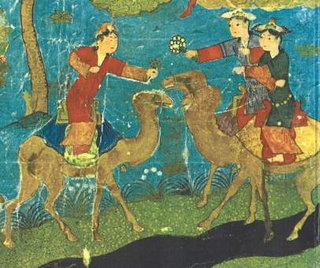Related Research Articles

The Quran, also romanized Qur'an or Koran, is the central religious text of Islam, believed by Muslims to be a revelation from God. It is organized in 114 chapters, which consist of verses. In addition to its religious significance, it is widely regarded as the finest work in Arabic literature, and has significantly influenced the Arabic language.

In Islamic religious belief, houris, are women with beautiful eyes who are described as a reward for the faithful Muslim believers in Paradise. The term is used four times in the Quran, where they are mentioned indirectly several other times,, and Hadith provide a "great deal of later elaboration". They have been said to have "captured the imagination of Muslims and non-Muslims alike". Muslim scholars differ as to whether they refer to the believing women of this world or a separate creation, with the majority opting for the latter.
Abū Jaʿfar Muḥammad ibn Jarīr ibn Yazīd al-Ṭabarī, more commonly known as al-Ṭabarī (الطبري), was a Muslim historian and scholar from Amol, Tabaristan. Among the most prominent figures of the Islamic Golden Age, al-Tabari is known for his historical works and his expertise in Qur'anic exegesis, but he has also been described as "an impressively prolific polymath". He wrote works on a diverse range of subjects, including world history, poetry, lexicography, grammar, ethics, mathematics, and medicine.
Tafsir refers to exegesis, usually of the Quran. An author of a tafsir is a mufassir. A Quranic tafsir attempts to provide elucidation, explanation, interpretation, context or commentary for clear understanding and conviction of God's will.
Al-Ikhlāṣ, also known as the Declaration of God's Unity and al-Tawhid, is the 112th chapter (sūrah) of the Quran.

Al-Baqara, alternatively transliterated Al-Baqarah, is the second and longest chapter (surah) of the Quran. It consists of 286 verses (āyāt) which begin with the "mysterious letters" ("muqatta'at") A.L.M. In recitation the names of the letters are used, not their sounds. Q2:282 is the longest single verse in the Quran. It is concerned with agricultural futures contracts.
Al-Insan ("Man") is the 76th chapter (surah) of the Quran, with 31 verses (ayat).
At-Takwīr is the eighty-first chapter (sura) of the Qur'an, with 29 verses (ayat). It tells about signs of the coming of the day of judgement. Some of these signs include the following:
Al-Muṭaffifīn is the eighty-third surah of the Qur'an. It has 36 ayat or verses.
ʿAbd Allāh ibn ʿAbbās, also known as Ibn ʿAbbās, was one of the cousins of the Islamic prophet Muhammad. He is considered to be the greatest mufassir of the Qur'an.
Muhammad Ibn Sirin was a Muslim tabi' who lived in the 8th century CE. He was a contemporary of Anas ibn Malik. He is claimed by some to have been an interpreter of dreams, though others regard the books to have been falsely attributed to him. Once regarded as the same person as Achmet son of Seirim, this is no longer believed to be true, as shown by Maria Mavroudi.
Sunan Ibn Mājah is one of the six major Sunni hadith collections. The Sunan was authored by Ibn Mājah.

Mid-Sha'ban is a Muslim holiday observed by Shia and Sunni Sufi Muslim communities on the eve of 15th of Sha'ban — the same night as Shab-e-barat or Laylat al-Bara’ah.

Jāmiʿ al-bayān ʿan taʾwīl āy al-Qurʾān, popularly Tafsīr al-Ṭabarī, is a Sunni tafsir by the Persian scholar Muhammad ibn Jarir al-Tabari (838–923). It immediately won high regard and retained its importance for scholars to the present day. It is the earliest major running commentary of the Quran to have survived in its original form. Like his history, al-Tabari's tafsir is notable for its comprehensiveness and citation of multiple, often conflicting sources. The book was translated into Persian by a group of scholars from Transoxania on commission of the Samanid king, Mansur I (961–976).
The Verse of Light is the 35th verse of the 24th surah of the Quran (Q24:35).
Shaykh 'Abd al-Ghani ibn Isma′il al-Nabulsi (an-Nabalusi), was an eminent Sunni Muslim scholar, poet, and author on works about Sufism, ethnography and agriculture.
Abu Bakr Muhammad ibn Ishaq ibn Khuzaymah was a prominent Muslim Muhaddith and Shafi'i jurist, best known for his hadith collection, Sahih Ibn Khuzaymah.
Al-Burhan fi Tafsir al-Quran or Kitab al-Burhan fi Tafsir al-Quran, popularly known as Tafsir al-Burhan, is a Shi'a Muslim tafsir written by Syed Hashim bin Sulaiman bin Ismail al Husaini al Bahrani.

This article deals with verses from the Quran that are said to have been revealed about Ali ibn Abi Talib. In a hadith attributed to Ibn Abbas, he knows more than 300 verses of the Quran about Ali.